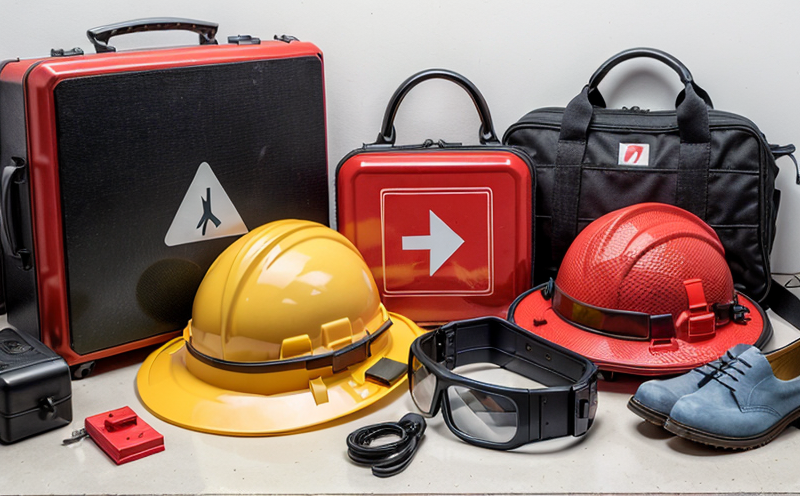JIS T8123 Protective Clothing for Emergency Operations Resistance Control
The JIS T8123 standard pertains to protective clothing designed specifically for emergency operations. This testing ensures that the clothing provides adequate resistance against various hazardous substances, chemicals, and physical impacts encountered during rescue missions or other high-risk tasks.
Protective clothing plays a crucial role in occupational safety by providing a barrier between personnel and potential hazards present at disaster sites. The standard emphasizes performance under extreme conditions, ensuring that emergency responders are equipped with garments capable of withstanding harsh environments without compromising mobility or comfort.
The testing procedure outlined in JIS T8123 involves rigorous evaluation across multiple parameters to verify compliance with specified criteria. These tests simulate realistic operational scenarios where the clothing must perform reliably against expected stressors like heat, chemicals, and mechanical forces. By adhering strictly to this standard, laboratories can provide assurance that emergency responders are utilizing equipment that meets stringent safety standards.
Understanding the intricacies of JIS T8123 is essential for those involved in designing, manufacturing, or purchasing protective clothing intended for use in emergencies. Compliance with these regulations not only enhances user confidence but also contributes significantly towards reducing workplace accidents and fatalities associated with improper protection gear.
For instance, fire departments often rely on specialized garments that conform to JIS T8123 specifications when dealing with hazardous materials spills or structural collapses. Similarly, rescue squads may opt for similar attire while tackling chemical leaks or biological hazards during industrial incidents. Such adherence ensures consistent quality across different brands and models, thereby promoting safer working practices throughout the industry.
The importance of meeting JIS T8123 cannot be overstated given its direct implications on public safety and health outcomes. By implementing robust testing protocols based on this international standard, manufacturers can produce reliable protective clothing that withstands even the harshest conditions faced by emergency responders.
Scope and Methodology
| Test Parameters | Description |
|---|---|
| Chemical Resistance Test | Evaluates the garment's ability to resist penetration by corrosive substances. |
| Heat Transfer Rate Measurement | Determines how effectively heat is transferred through the fabric. |
| Mechanical Strength Assessment | Tests resistance against tearing or punctures under specified loads. |
| Breathability Analysis | Assesses the permeability of moisture vapor through the material. |
The methodology for conducting JIS T8123 tests is meticulously defined, ensuring consistent results across various laboratories. Each parameter listed above requires specific apparatus and techniques to accurately measure performance characteristics.
For example, during the chemical resistance test, a standardized solution containing corrosive agents is applied to predefined areas of the fabric sample. The extent of penetration within set time limits provides critical insights into the garment's protection level against hazardous substances. Similarly, heat transfer rate measurements involve controlled exposure to thermal gradients followed by analysis of temperature changes across different points on the material.
Mechanical strength assessments typically employ tensile testers capable of applying known forces until failure occurs, while breathability analyses utilize specialized equipment that simulates real-world conditions experienced during prolonged periods of wear. These comprehensive evaluations ensure that protective clothing not only meets but exceeds expectations set forth by JIS T8123.
Customer Impact and Satisfaction
- Increased confidence among emergency responders regarding their personal safety when utilizing compliant garments.
- Enhanced reputation of organizations providing reliable protective equipment that adheres to recognized international standards.
- Potential cost savings due to reduced incident rates caused by improper protection gear.
Customer satisfaction is paramount, and meeting JIS T8123 contributes significantly towards achieving this goal. Emergency services personnel feel more secure knowing they are equipped with high-quality protective clothing that has undergone stringent testing procedures endorsed globally.
For organizations supplying such products, compliance brings additional advantages like increased market share and improved brand loyalty among discerning customers who prioritize safety above all else. Moreover, by demonstrating adherence to internationally recognized standards, these entities can foster trust within both internal stakeholders as well as external partners involved in disaster response efforts.
Competitive Advantage and Market Impact
- Prioritizing JIS T8123 compliance allows businesses to differentiate themselves from competitors offering substandard or uncertified products.
- Adherence to this standard enables companies to participate in tenders requiring specific safety certifications, thereby expanding their customer base.
- Increased competitiveness through superior product quality and reliability, which translates into enhanced performance metrics for all involved parties.
The competitive landscape surrounding protective clothing for emergency operations is increasingly demanding. Organizations that prioritize JIS T8123 compliance gain significant advantages in terms of market share and brand recognition. By ensuring their offerings meet or exceed these stringent requirements, firms can position themselves as leaders within the industry.
From a broader perspective, meeting JIS T8123 contributes positively to overall market health by fostering higher standards across the sector. This collective improvement benefits not only individual enterprises but also society at large through safer working environments and improved emergency response capabilities.





